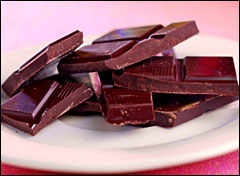The connection between chocolate and Eros runs deep.

How do I love thee? Let me taste the ways.
Photo: iStockphoto
In southern Mexico — where chocolate cultivation probably originated — the treat figured among the wedding rituals of the ancient Maya. By the time it became popular in Europe in the 18th century, a Venetian named Casanova was crediting chocolate with boosting his romantic prowess.
Modern science confirms the beliefs behind this long-held tradition. Chocolate contains tryptophan and phenylethylamine — two chemicals thought to trigger sensations in the brain similar to falling in love. So its status as the Valentine’s Day gift par excellence makes plenty of sense.
Yet like coffee and other tropical commodities popular in the global north, chocolate has deeply troubling qualities as well. Six chocolate manufacturers process half of the globe’s cocoa, giving them tremendous leverage to dictate prices and conditions experienced by farmers. In the United States, an eight-company trade group called the Chocolate Manufacturers Association claims to “represent over 90 percent of the chocolate processed in the United States.”
GRIST’S PICK
Rapunzel
Organic Swiss Chocolate
$2.29 for 3 oz.
As a result of this hyper-consolidation, conditions in the cocoa-growing world tend to be wretched. In the Ivory Coast, source of 40 percent of the world’s cocoa beans, cocoa farms often run on forced child labor.
Since there’s nothing sexy about slavery, romantics planning to revel in chocolate this Valentine’s Day should avoid conventional supermarket chocolate. Besides, that stuff is produced mainly with a cheap, sugary jolt in mind — not the sort of sensual experience proper for Valentine’s Day.
During a recent visit to Grist headquarters in Seattle, I led the (very enthusiastic) staff on a tasting from small manufacturers that buy only Fair Trade and/or organic cocoa beans. To get to chocolate’s full flavorful potential, we looked for bars with at least 70 percent cocoa content. We also limited our tasting to chocolates with national distribution.
We tasted our six chocolates blind, sniffing them and letting them melt slowly in our mouths. Each person rated the various options on a scale from one to 10, scribbling down reactions. Here’s what we found.
1. Equal Exchange
Very Dark Chocolate, 71 percent cocoa
Certifications: Organic and Fair Trade
Price: $2.79/3 oz.
Avg. Score: 7
This popular national brand made a strong showing. I found it balanced but unexciting; supporters praised its “creamy, bold finish.” Several tasters found flowery notes; a few declared it “winy.”
2. Endangered Species
Supreme Dark Chocolate, 72 percent cocoa
Certifications: “100 percent ethically traded”
Price: $2.19/3 oz.
Avg. Score: 7
Another strong showing for a widely available workhorse. I found pleasant milk-chocolate and coconut notes, though the flavor struck me as too soft for what I like in dark chocolate. Some loved it. “Leaves me delighted,” wrote one staffer; “sinful — this should be taxed,” wrote another. To one detractor, it “tastes like Dove”; and worse, “like there are unwanted ingredients.”
3. Trader Joe’s
Super Dark, 73 percent cocoa
Certifications: Organic and Fair Trade
Price: $2.00/3 oz.
Avg. Score: 5.4

Consumer Reports’ GreenerChoices.org features three labels that can benefit people and the planet: Organic, Fair Trade, and Rainforest Alliance. Learn more.
This one generated a wide range of reactions. I noted an olive-like flavor, and found it refreshingly complex compared to earlier samples. Another highly opinionated taster found it “nice,” even though a “burnt, bitter flavor slightly overpowers” it. Yet one of its many detractors wondered whether it had spent time “in the freezer and absorbed the flavors of everything in there.”
4. Rapunzel
Organic Swiss Chocolate, 70 percent cocoa
Certifications: Organic and Fair Trade
Price: $2.29/3 oz.
Avg. Score: 7.1
It was good to see this Fair Trade pioneer, which has been pumping out “ethical” chocolates for decades, make such a strong showing. In fact, it narrowly won our competition. I found it satisfying, with a distinct if one-note coffee/espresso flavor. Several others found a similar flavor profile. “Tastes like a mocha delight!” gushed one. Yet it was not universally loved. “Tastes flat and cloying,” averred a detractor. “Unimpressive. Blech. Crappy.”
5. Theo
Ghana Panama Ecuador, 75 percent cocoa
Certifications: Organic and Fair Trade
Price: $5.19/3 oz.
Avg. Score: 4.1
This Seattle-area small-batch favorite was a disappointment — at least the variety we got our hands on. I found it one-dimensional and flat, its super-subtle flavor hindered by a slight off-taste. Another detractor found “freezer-burned ice cube” notes. Yet it had its supporters. One praised its “smooth, velvety texture.” Another declared it “nice, subtle.”
6. Dagoba
New Moon, 74 percent cocoa
Certifications: Organic
Price: $2.59/2 oz.
Avg. Score: 4.8
Another poor showing by a cult favorite. I actually liked it quite well, finding powerful, winy flavors — the kind of complexity I want in dark chocolate. Another lover of bold chocolates declared it “chocolatey, in your face”; another wrote, “tastes less processed [than the others] … has a strong taste of cocoa nibs.” Several detractors found it “too bitter.” Complained one: “it gave me cotton mouth.” Others found it too sweet.
The bottom line: While Rapunzel took the top prize by a hair, several brands scored well, and our panel’s favorite chocolates are all widely available and affordable. You don’t need to stray too far from the average natural-foods supermarket to find beguiling “sweets for the sweet” this Valentine’s Day — but for those willing to roll the dice, pay a little more, and cast a wider net, there are delights to be found in more idiosyncratic chocolates as well. Our two lowest-scoring samples — from Theo and Dagoba — both won passionate admirers. Incidentally, Grist senior editor and chocolate fanatic Lisa Hymas insists that most of Theo’s flavors rule: “For your own edification, try some of the others!”

